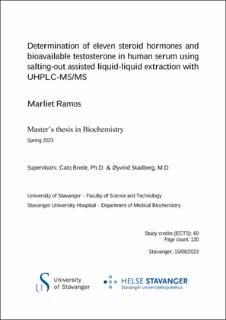| dc.description.abstract | Steroid hormones are essential in various biological roles such as the regulation of sexual maturation, fertility, bone and muscle growth, stress-mediated responses, and inflammation, to name a few examples. Impaired steroidogenesis leads to anomalous steroid hormone concentrations and develops into endocrinological disorders, such as polycystic ovarian syndrome (PCOS) and hypogonadism, with physical and mental manifestations affecting life quality and possibly longevity. The detection of aberrant steroid concentrations is crucial for diagnosis and requires adequate biochemical assays to provide correct and reliable quantitation. Ultra-high-performance liquid chromatography (UHPLC-MS/MS) provides greater selectivity and sensitivity for endocrine analysis compared to modern direct immunoassays.
This study optimized and validated an UHPLC-MS/MS method using salting-out assisted liquid-liquid extraction (SALLE) for sample clean-up and analyte extraction of 11 steroid hormones from human serum. The analyte panel includes glucocorticoids (cortisol, cortisone, corticosterone, deoxycorticosterone, 11-deoxycortisol), progestogens (progesterone, 17α-hydroxyprogesterone) and androgens (total testosterone, bioavailable testosterone, androstenedione, 11-ketotestosterone, 11β-hydroxyandrostenedione). Additionally, the study involved the analysis of 38 sera samples from healthy individuals through the project “Blood Reference in Stavanger (BRIS)”. The method exhibited its ability as a diagnostic tool by identifying three individuals with anomalous androgen concentrations, including the 11-oxygenated androgens, from the small population cohort studied.
The proposed multiplex method demonstrated high-throughput performance with a 2.67-minute cycle time per injection and a fully automated sample preparation with large sample capacity and high time and cost efficiency. Sensitive detection for all analytes was achieved with detection limits (LOD) and quantification limits (LOQ) at 0.01 – 0.12 nmol/L and 0.03 – 0.29 nmol/L, respectively. Satisfactory intermediate precision was found for total testosterone (6%), cortisol (11%), cortisone (4%), progesterone (5%), 17α-hydroxyprogesterone (7%), androstenedione (11%), and corticosterone (6%) in the upper range of endogenous hormone concentrations in real human serum. Additionally, the imprecision of total testosterone in the lower concentration range, corresponding to female endogenous levels, was 8%. Higher imprecisions were observed for deoxycorticosterone (23%), 11-deoxycortisol (16%), 11-ketotestosterone (17%), 11β-hydroxyandrostenedione (11%) due to limitations in the endogenous levels of these steroid hormones, and bioavailable testosterone (21%).
The method can simultaneously determine 11 steroid hormones from one single analysis, enabling the exploration of hormone patterns and the intracrine relationship in endocrinological conditions. Multiplex steroid analysis by UHPLC-MS/MS is advantageous in the exclusion of differential diagnoses, replacing multiple single-analyte assays, and expanding the analyte panel to include other steroid hormones such as 21-deoxycortisol and oestrogens. | |
